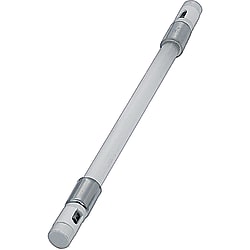(!)NOTE : Windows 7 users won’t be able to use some latest features of eCatalog/WOS since Microsoft is ending support for Windows 7 on 14 Jan, 2020. Please upgrade your system for uninterrupted services.
- Notice of End of Sales for Economy Series Pneumatic Equipment Category. More information.
Quartz Far Infrared Heaters (Part Number)
You can add up to 6 items per a category to the compare list.
Part Number :

Copy Part Number URL to Clipboard
The part number URL has been copied into your clipboard.-
- Order Qty :
-
-
- Price :
- ---
-
- Total Price :
- ---
-
- Days to ship :
- ---
Select part number to Order Now/ Add to Cart
Product Description
This is a quartz glass tube heater. [Material of Exothermic Part]Quartz glass [Infrared Type] Quartz glass tube

- Quartz Far Infrared Heaters
[ M ] Materials:
Quartz Tube : Quartz Glass
Heater Cap : Brass + Nickel Plating
Terminal : 303 Stainless Steel Equivalent
- Reflection Mirror
[ M ] Materials:
Reflection Mirror : A1050
Side Plate : A1050
Holder Mounting Metal Fitting: SS400 + Ni Chrome Plating
Specifications
| Part Number | - | L | - | V |
| MPHHS | - | 150 | - | V100 |

Part Number
- Incomplete part number.
Please use left hand selections to complete a part number.
Loading...
| Part Number |
|---|
| MPHH-[150-600/10]-V[100,200] |
| MPHHS-[150-600/10]-V[100,200] |
| Part Number | Price | Minimum Order Qty. | Volume Discount | Days to Ship | RoHS | Voltage (V) | Length (mm) | Sale Type |
|---|---|---|---|---|---|---|---|---|
- | 1 Piece(s) | 10 Day(s) or more | 10 | 100 ~ 200 | 150 ~ 600 | Heater Only | ||
- | 1 Piece(s) | 10 Day(s) or more | 10 | 100 ~ 200 | 150 ~ 600 | Package Sales |
Loading...
More Information
■Features
- The quartz far infrared heater has Nickel-chrome wires wrapped inside the quartz glass tube, which irradiate far infrared ray to the heated objects.
- Although its function is similar to that of far infrared ceramic heaters, compared with ceramic heater it has the features as follows: (1) Rise/Drop in temperature are quick after the power is supplied (2)Relatively broad heat distribution (3) Irradiated heat direction is easily controllable
- The far infrared ray uniformly heats the surface and interior of the object.
- The temperature adjustment can be done by adjusting the distance to the heated object.
- This is a clean heater with little dust scattering. The used quartz tube has excellent chemical resistance.
- By using the reflection mirror, the irradiation direction of far infrared ray can be controlled, and more effective heat radiation can be obtained.
■Notes on Use
- These products are made of glass. Be extremely careful with handling, since it is easy to break.
Turn off the power immediately when broke during operation.
-These products are for horizontal (lateral) use. Not usable in position of vertical (standing positioned) and slant (oblique positioned).
-This heater becomes very hot. It may result in burn injury if touched while light is on or immediately after lights-out.
- The cap part (insulators on both ends of quartz tube) should be used at the temperature lower than 100°C.
- Do not touch the glass tube by bare hand. Sodium from sweat decreases the mechanical strength of quarts tubes.
- The quartz far infrared heater has Nickel-chrome wires wrapped inside the quartz glass tube, which irradiate far infrared ray to the heated objects.
- Although its function is similar to that of far infrared ceramic heaters, compared with ceramic heater it has the features as follows: (1) Rise/Drop in temperature are quick after the power is supplied (2)Relatively broad heat distribution (3) Irradiated heat direction is easily controllable
- The far infrared ray uniformly heats the surface and interior of the object.
- The temperature adjustment can be done by adjusting the distance to the heated object.
- This is a clean heater with little dust scattering. The used quartz tube has excellent chemical resistance.
- By using the reflection mirror, the irradiation direction of far infrared ray can be controlled, and more effective heat radiation can be obtained.
■Notes on Use
- These products are made of glass. Be extremely careful with handling, since it is easy to break.
Turn off the power immediately when broke during operation.
-These products are for horizontal (lateral) use. Not usable in position of vertical (standing positioned) and slant (oblique positioned).
-This heater becomes very hot. It may result in burn injury if touched while light is on or immediately after lights-out.
- The cap part (insulators on both ends of quartz tube) should be used at the temperature lower than 100°C.
- Do not touch the glass tube by bare hand. Sodium from sweat decreases the mechanical strength of quarts tubes.
■Usage
- Desiccation of the Base and Material
- Baking Finish and Desiccation of the Coat
Because infrared ray heats the object directly through no air, it is more efficient.
- Desiccation of the Base and Material
- Baking Finish and Desiccation of the Coat
Because infrared ray heats the object directly through no air, it is more efficient.
Example

Basic Information
| Application | Workpiece | Usage Pattern | Single Item | Heating Area Material | Silica Glass |
|---|---|---|---|---|---|
| Infrared Ray Type | Quartz Glass Pipe | Category | Heater Main Body |
- The specifications and dimensions of some parts may not be fully covered. For exact details, refer to manufacturer catalogs .







How can we improve?
How can we improve?
Thank you for your time.
Your feedback is essential for our continuous improvement
Privacy Policy
Thank you for your cooperation.
Thank you for your time.
Your feedback is essential for our continuous improvement
Please use the inquiry form.
Privacy Policy